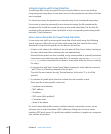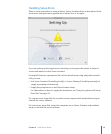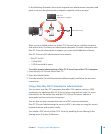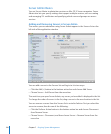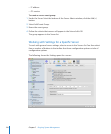
12 4
This chapter shows you how to complete ongoing
management for your systems, including setting up
administrator computers, designating administrators,
and maintaining service uptime.
Read the following sections as a basic introduction to Mac OS X Server management:
“ Â Computers You Can Use to Administer a Server” on page 124
“ Â Using the Administration Tools” on page 126
“ Â Changing the Server’s Computer Name and the Local Hostname” on page 144
“ Â Adding and Removing Servers in Server Admin” on page 12 8
“ Â Administering Services” on page 145
“ Â Tiered Administration Permissions” on page 149
“ Â Workgroup Manager Basics” on page 150
Computers You Can Use to Administer a Server
To administer a server locally using the graphical administration applications (in
/Applications/Server/) log in to the server as a server administrator and open them.
To administer a remote server, open the applications on an administrator computer.
An administrator computer is any Mac OS X Server v10.6 or Mac OS X v10.6 or later
computer where the administration tools have been installed from the Mac OS X Server
Admin Tools CD. See “Setting Up an Administrator Computer” on page 124 .
You can run command-line tools from the Terminal Application (in
/Applications/Utilities/) on any Mac OS X Server or Mac OS X computer. You can also
run command-line tools from a UNIX workstation.
Setting Up an Administrator Computer
An administrator computer is a computer with Mac OS X v10.6 or
Mac OS X Server v10.6 or later that you use to manage remote servers.
7
Ongoing System Management





